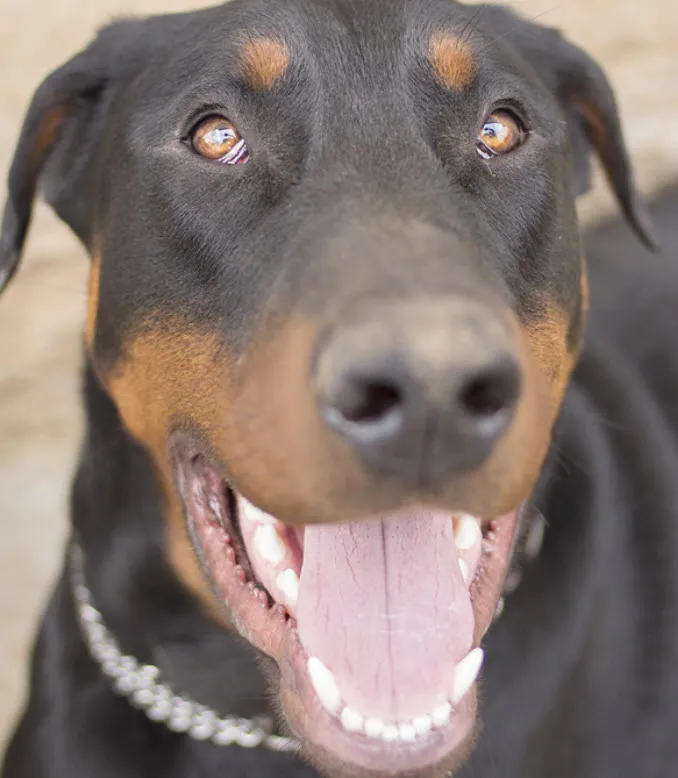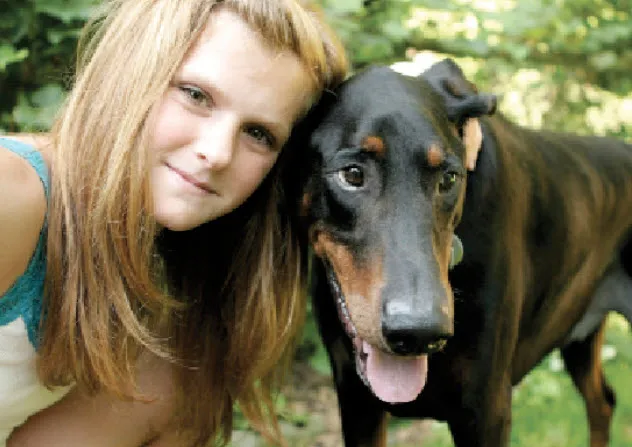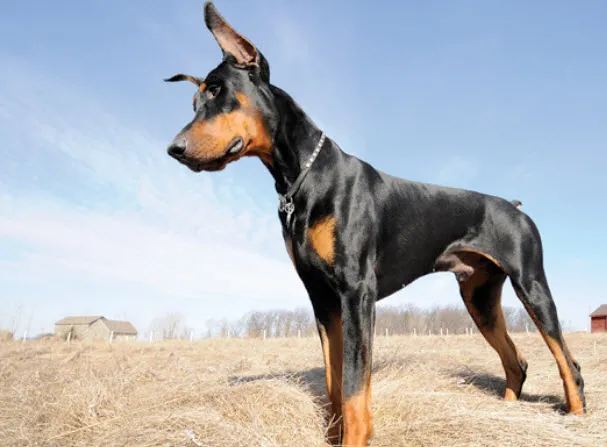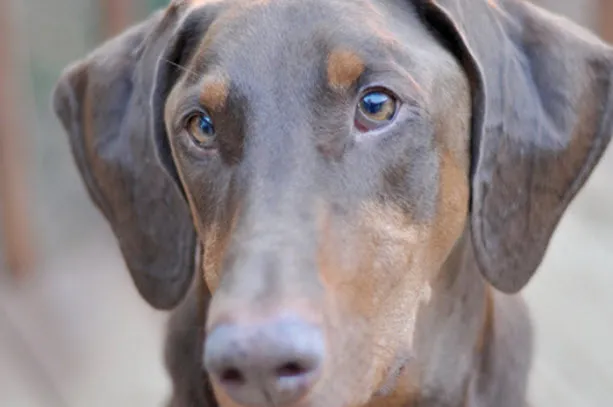The Doberman Pinscher, with its sleek appearance and noble demeanor, is renowned for its vigilance, loyalty, and affectionate nature. This breed can make a wonderful addition to many families, offering an energetic and playful companion, an obedient and devoted friend, and an excellent guard dog. Their strong, athletic build and keen intelligence make them highly trainable and eager to please. However, potential owners must also be aware of certain characteristics that require proper management. Without adequate socialization, Dobermans can become aggressive, fearful, or snappy. They demand vigorous, frequent exercise and ample space to run, as boredom and separation anxiety can lead to destructive behaviors like chewing and howling. Young Dobermans, especially, can be rambunctious and rowdy. If not properly socialized, they may become overprotective of their family and territory. This sensitive breed matures slowly, requiring patience and consistent training. Understanding these traits is the first step in providing optimal Doberman Care.
The Doberman Pinscher is a relatively modern breed, developed in the late 19th century by a German tax collector, Louis Dobermann, who sought to create a protector for his travels. To this day, Dobies excel as natural guardians, often requiring little additional training for protective instincts. While not inherently aggressive, early and proper socialization during puppyhood is crucial to teach them appropriate interaction behaviors with people and other animals. When encouraged and well-exercised, they become wonderful family members. Dobermans are intelligent and possess impressive stamina, thriving when given a “job” or plenty of physical and mental stimulation. Generally, Doberman Pinschers are a healthy breed with an average lifespan of up to 13 years, but proactive care is key to their longevity. For comprehensive veterinary services and to discuss any specific needs for your Doberman, seeking professional advice is always recommended.
Understanding Your Doberman Pinscher’s Needs
Providing the best Doberman care involves understanding their unique needs, from their spirited personality to their distinct health predispositions. As devoted companions, Dobermans thrive on interaction and purpose. Their intelligence means they learn quickly, but it also means they require consistent mental engagement to prevent boredom. Regular training, puzzle toys, and engaging activities are essential to keep their sharp minds occupied. Physically, their athletic build demands daily exercise beyond a simple walk; they excel in activities like agility, obedience, and even dock diving. A well-exercised and mentally stimulated Doberman is a happy Doberman, less prone to behavioral issues.
 A vigilant Doberman Pinscher with a focused expression, ideal for illustrating alertness.
A vigilant Doberman Pinscher with a focused expression, ideal for illustrating alertness.
General Health Information for Optimal Doberman Care
As with all dog breeds, general health maintenance forms the foundation of good Doberman care. Staying informed about common canine health issues and their specific relevance to Dobermans can help you maintain your pet’s well-being throughout their life.
Dental Disease
Dental disease is a pervasive issue in pets, affecting a vast majority of dogs by the age of two. Doberman Pinschers are particularly susceptible to dental problems. This condition begins with tartar accumulation and can advance to infections of the gums and tooth roots. If left untreated, dental disease can lead to tooth loss and negatively impact vital organs like the kidneys, liver, heart, and joints, potentially shortening your Dobie’s lifespan by one to three years. Regular professional dental cleanings and consistent home care, such as brushing your dog’s teeth at least twice a week, are essential for preventing these issues.
Infections
Doberman Pinschers are vulnerable to common bacterial and viral infections that affect all dogs, including parvovirus, rabies, and distemper. Fortunately, many of these infections are preventable through a tailored vaccination schedule recommended by your veterinarian. The specific vaccinations will depend on your dog’s age, local disease prevalence, and other individual factors. Keeping up-to-date with vaccinations is a critical aspect of preventive doberman care.
Obesity
Obesity poses a significant health risk for Doberman Pinschers. It is a serious condition that can exacerbate joint problems, contribute to metabolic and digestive disorders, cause back pain, and worsen heart disease. While it’s tempting to indulge your Doberman with treats, overfeeding with human food and excessive dog treats can lead to severe health consequences. Instead of food, offer affection through hugs, grooming, playtime, or walks. These activities provide positive reinforcement without contributing to weight gain, promoting a healthier and happier Doberman.
Parasites
Dobermans can be affected by various internal and external parasites. External parasites like fleas, ticks, and ear mites can infest their skin and ears, causing discomfort and potential skin infections. Internal parasites, including hookworms, roundworms, heartworms, and whipworms, can enter their system through contaminated water, soil, or mosquito bites. Some of these parasites can be transmitted to humans, making regular testing and preventive medication crucial for both your pet’s health and your family’s safety. Consistent parasite control is a fundamental component of effective doberman care.
 A close-up of a Doberman Pinscher, highlighting its alert and expressive face.
A close-up of a Doberman Pinscher, highlighting its alert and expressive face.
Spay or Neuter
Spaying (for females) or neutering (for males) is one of the most beneficial procedures you can perform for your Doberman. This surgical intervention removes the ovaries and typically the uterus in females, and the testicles in males. It significantly reduces the risk of certain cancers and eliminates the possibility of unwanted pregnancies. This procedure also offers an opportunity for veterinarians to identify and address other potential health issues while your pet is under anesthesia, such as hip X-rays or puppy tooth extractions. Pre-surgical blood testing helps identify and mitigate anesthetic or surgical risks. These discussions will be thoroughly reviewed with you prior to the procedure.
Genetic Health Predispositions in Dobermans
Doberman Pinschers are predisposed to several genetic conditions, making awareness and early detection vital for effective doberman care. Regular veterinary check-ups and specific diagnostic screenings can help manage these risks.
Heart Disease
Dobermans are particularly prone to dilated cardiomyopathy (DCM), a life-threatening heart condition where the heart becomes enlarged, thin, and weak, impairing its ability to pump blood efficiently. As DCM progresses, your Doberman may exhibit weakness, fatigue, fainting, labored breathing, or coughing. Annual electrical heart screenings (ECG) and/or echocardiograms are recommended, sometimes as early as one year of age, to detect abnormal heart rhythms. Treatment, if indicated, may involve medication and dietary supplements. Early intervention is crucial for managing this serious condition.
Neurological Disease
Wobbler disease, or wobbler syndrome, is a genetically linked neurological condition that can cause an unsteady, “wobbly” gait in affected Dobermans. This condition results from a narrowing of the vertebrae in the neck, which pinches the spinal cord and associated nerves. When these nerves are compressed, they fail to transmit signals properly, leading to impaired sensation in the feet. Initial signs often include unstable hind legs, stumbling, and occasional falls. Treatment options range from medications and neck braces to rehabilitation exercises and, in some cases, surgery.
Bloat (Gastric Dilatation Volvulus – GDV)
Gastric dilatation volvulus (GDV), commonly known as bloat, is a life-threatening emergency primarily affecting large, deep-chested breeds like the Doberman Pinscher. In this condition, the stomach twists on itself and fills with gas, cutting off the blood supply to the stomach and sometimes the spleen. If not treated immediately, bloat can be fatal within hours. Symptoms include non-productive retching, restlessness, an enlarged or tight abdomen, or assuming a “prayer position” (front feet down, hindquarters up). Preventive surgery, called gastropexy, which tacks the stomach in place to prevent twisting, is an option. If you observe any symptoms of bloat, seek emergency veterinary care immediately.
Bleeding Disorders
Dobermans are susceptible to several inherited bleeding disorders, which vary in severity. Often, these conditions go unnoticed until a severe injury or surgery triggers excessive bleeding. Dobermans are particularly prone to certain rare blood diseases.
- Immune-Mediated Hemolytic Anemia and Thrombocytopenia: These conditions occur when the immune system mistakenly attacks the body’s own red blood cells or platelets. Destruction of red blood cells leads to anemia, weakness, and lethargy, often indicated by pale or yellowish gums. If platelets are destroyed, blood clotting is impaired, leading to bruising or abnormal bleeding. Diagnostic tests for blood clotting are typically performed before any surgical procedures. Treatment involves steroids and other immune-suppressive drugs to halt the immune system’s attack, and emergency transfusions may be necessary.
- Von Willebrand’s Disease: This is a common blood clotting disorder in Doberman Pinschers. Veterinary professionals typically conduct diagnostic tests for blood clotting times or a specific DNA blood test for Von Willebrand’s disease and similar disorders prior to surgery to assess this risk.
Liver Problems
Doberman Pinschers are prone to chronic liver disease, such as hepatitis, which can manifest in middle age. Diagnosis usually involves blood testing and liver biopsy, with treatment often including medication and a specialized diet. Symptoms of liver disease often don’t appear until significant damage has occurred, making early detection through routine blood screenings critical for more effective and treatable outcomes. Some Dobermans can also develop copper hepatopathy, a disorder where toxic levels of copper accumulate in the liver, leading to liver failure if untreated. Affected dogs typically show signs of jaundice (yellow eyes, gums, and skin) between two and four years of age. Early life liver testing is recommended to screen for such abnormalities.
 A Doberman Pinscher running freely in a field, showcasing its athletic build and need for exercise.
A Doberman Pinscher running freely in a field, showcasing its athletic build and need for exercise.
Diabetes Mellitus
Diabetes mellitus is a relatively common canine disease, and Dobermans have an above-average incidence rate. Diabetic dogs are unable to regulate their blood sugar metabolism and require daily insulin injections. This is a serious condition that necessitates early diagnosis and treatment. Symptoms include increased eating, drinking, and urination, alongside weight loss. If these signs are observed, laboratory tests will confirm the condition, and treatment options will be discussed. While managing diabetes requires significant commitment, well-regulated diabetic dogs can have a life expectancy comparable to other canines.
Eye Problems
Proper eye function dramatically impacts a dog’s quality of life. Unfortunately, Doberman Pinschers can inherit or develop several eye conditions, some of which may cause blindness if not promptly treated, and most can be extremely painful. Regular veterinary examinations will include a thorough evaluation of your Doberman’s eyes to look for any signs of concern.
Kidney Disease (Glomerulonephropathy)
Glomerulonephropathy is an inherited disease that progressively damages a Doberman Pinscher’s kidneys, often leading to early kidney failure. Damaged kidneys leak protein, so annual urine testing for excessive protein can aid in early diagnosis. Early detection typically leads to better outcomes and more manageable treatment plans, which may include a special diet.
Bone and Joint Problems
Doberman Pinschers can experience various musculoskeletal issues. While these may seem daunting, each condition can be diagnosed and treated to alleviate pain and suffering. Diligent observation at home and knowledge of these potential diseases will enable you to provide excellent doberman care throughout your dog’s life.
- Intervertebral Disc Disease (IVDD): This common condition in Dobermans occurs when the jelly-like cushion between vertebrae slips or ruptures, compressing the spinal cord. Signs include sudden inability or reluctance to jump or use stairs, reluctance to move, a hunched back, crying out, or refusal to eat or eliminate. Severe cases can lead to sudden paralysis, where the dog drags its hind feet or cannot use its back legs. Prompt veterinary attention is critical. Surgical removal of ruptured discs, ideally within 24 hours, often yields the best results for paralysis. Less severe cases may resolve with rest and medication. Weight control is crucial for reducing IVDD risk, and providing ramps or steps from puppyhood can prevent back strain from jumping onto furniture.
- Eosinophilic Panosteitis (“Pano”): Growing Dobermans, typically between six and ten months of age, can suffer from this painful inflammation of the long bones in the legs. Pano often shifts from leg to leg. Veterinarians will check for this condition during examinations, and if pain is noted upon palpation, X-rays confirm the diagnosis. Panosteitis usually causes no permanent damage but requires pain medication. Rehabilitation exercises may be necessary if an abnormal gait develops due to the pain.
- Arthritis: Many older dogs develop arthritis, and larger breeds like Dobermans are particularly prone to more pain and disability from it. Various treatments are available, with earlier intervention leading to better outcomes. Good nutrition and appropriate exercise are also vital for mitigating bone and joint problems as your Doberman ages. Preventing overweight conditions significantly reduces strain on their joints.
 A Doberman Pinscher sitting attentively, ready for a command or interaction.
A Doberman Pinscher sitting attentively, ready for a command or interaction.
Thyroid Problems
Dobermans are predisposed to hypothyroidism, a common condition where the body does not produce enough thyroid hormone. Symptoms can include dry skin and coat, hair loss, increased susceptibility to other skin diseases, weight gain, fearfulness, aggression, and other behavioral changes. Annual blood tests are recommended to screen for this disease. Treatment is typically straightforward, involving daily oral hormone replacement medication.
Cancer
Cancer is a leading cause of death in older dogs. Since Dobermans often live longer than many other breeds, they are more susceptible to developing cancer in their later years. Many cancers are curable with surgical removal, and some types respond well to chemotherapy. Early detection is paramount. Your veterinarian will perform periodic diagnostic tests and examine for lumps and bumps during routine check-ups.
Multiple Skin Problems
Dobermans are susceptible to various skin infections and diseases, necessitating diligent doberman care focused on dermatological health.
- Malassezia Dermatitis: This yeast infection can affect the ears, causing itching, redness, and a brown, waxy discharge. On the skin, it leads to greasy, hairless patches, especially on the neck and throat, often accompanied by a distinct odor.
- Seborrhea: Another common skin disease, seborrhea can result in either dry, flaky skin or greasy, oily skin. These conditions cause itchiness and discomfort for your Doberman. Bathing with specialized shampoos and rinses can be beneficial, and any underlying issues like allergies will also be treated. Prompt veterinary attention for skin problems can prevent them from escalating.
- Demodex Mites: These microscopic mites reside in the hair follicles of all dogs. Normally, a dog’s immune system keeps them in check, but certain breeds, including Dobermans, may develop an overabundance, leading to demodectic mange. In mild cases, owners might notice a few dry, irritated, hairless lesions, often on the face or feet, which may or may not be itchy. Secondary bacterial infections can also occur. Prompt veterinary care is crucial to prevent the disease from spreading. Many Dobermans outgrow the problem, while others require lifelong management.
- Pemphigus Foliaceus: This superficial skin disease is more common in Doberman Pinschers, typically appearing around four years of age. It causes crusts and hair loss, usually on the top of the nose and inside the ear flaps, and sometimes on the footpads and toenails. Secondary bacterial infections are common in these damaged areas. While crusts may wax and wane, there is no cure, but effective treatments exist. Sunlight can worsen the condition, so applying zinc-free sunscreen to sensitive areas before outdoor exposure can help.
- Lick Granuloma: While most dogs lick their bodies for grooming or minor wound care, some Dobermans may obsessively lick the same area repeatedly. This persistent licking can result in a deep skin callous known as a lick granuloma, usually on the legs, feet, or flank. Early veterinary intervention is critical upon noticing a granuloma, as these sores can be extremely challenging to cure once the repetitive behavior is established.
Proactive Doberman Care at Home
Much of what you can do to keep your Doberman happy and healthy aligns with common sense, similar to human health. A consistent routine of diet, exercise, grooming, and vigilant monitoring for unusual signs forms the cornerstone of effective doberman care. Adhering to recommended examination and vaccination schedules is crucial for preventative health screenings and addressing breed-specific conditions. Furthermore, considering pet health insurance can help cover the costs of necessary medical tests and procedures throughout your Doberman’s life.
 A playful Doberman Pinscher holding a ball, illustrating the breed's energetic nature.
A playful Doberman Pinscher holding a ball, illustrating the breed's energetic nature.
Routine Care, Diet, and Exercise
Establishing a consistent routine for your Dobie helps ensure a longer, healthier, and happier life. The importance of a proper diet and exercise routine cannot be overstated in Doberman care.
- Supervise: Treat your Doberman like a toddler; keep doors closed, pick up potential hazards, and block off rooms as needed. This prevents them from getting into trouble or ingesting inappropriate objects.
- Grooming: Dobermans have low grooming needs. A weekly brushing is usually sufficient to maintain their coat health.
- Dental Hygiene: Doberman Pinschers generally have good teeth, but maintaining their pristine condition requires brushing them at least twice a week.
- Ear Cleaning: Clean their ears weekly, even from puppyhood. Your vet can demonstrate the proper technique.
- Mental & Physical Stimulation: Dobermans are intelligent and high-energy dogs. Keep their minds and bodies active to prevent boredom, which can lead to destructive behaviors.
- Training: They are sensitive dogs and do not respond well to harsh training methods or punishment. Always conclude training sessions on a positive note to build a strong bond and encourage good behavior.
- Temperature Sensitivity: Dobermans can be sensitive to cold, so a warm winter wardrobe is necessary in colder climates.
- Diet: Maintain a consistent diet and avoid feeding human food. Always provide a high-quality diet appropriate for their age and activity level.
- Exercise: Exercise your Doberman regularly, but avoid overexertion, especially when they are young. Gradually increase activity levels to build stamina.
What to Watch For
Any abnormal symptom could indicate a serious underlying disease or merely a minor, temporary issue. The key is recognizing when and how urgently to seek veterinary assistance. Many diseases present with a characteristic combination of symptoms, providing clear signals that your Doberman Pinscher needs help. If you notice any unusual signs, it’s always best to consult your vet. Pet health needs can be diverse, and seeking professional veterinary advice is always recommended for comprehensive care.
Office Calls
Schedule an appointment with your veterinarian if you observe any of the following signs in your Doberman:
- Changes in appetite or water consumption.
- Tartar build-up, bad breath, red gums, or broken teeth.
- Itchy skin (scratching, chewing, or licking); hair loss.
- Lethargy, mental dullness, or excessive sleeping.
- Fearfulness, aggression, or other behavioral changes.
- Increased hunger and thirst, coupled with weight loss.
- Stiffness or reluctance to rise, sit, or use stairs.
- Dull coat, hair loss; sluggishness, unexplained weight gain.
Emergencies
Seek immediate medical care if you notice any of these critical signs in your Doberman:
- Scratching or shaking the head vigorously, tender ears, or ear discharge.
- Inability or straining to urinate; discolored urine.
- Cloudiness, redness, itching, or any other abnormality involving the eyes.
- Fainting, collapse; difficulty breathing, persistent coughing.
- Dry heaving or a visibly large, tight, painful abdomen (signs of bloat).
- Gums that are any color other than a normal bright pink.
- Severe depression, poor appetite, or yellowing of the eyes (jaundice).
Providing diligent and informed doberman care ensures your loyal companion lives a long, healthy, and happy life by your side.
